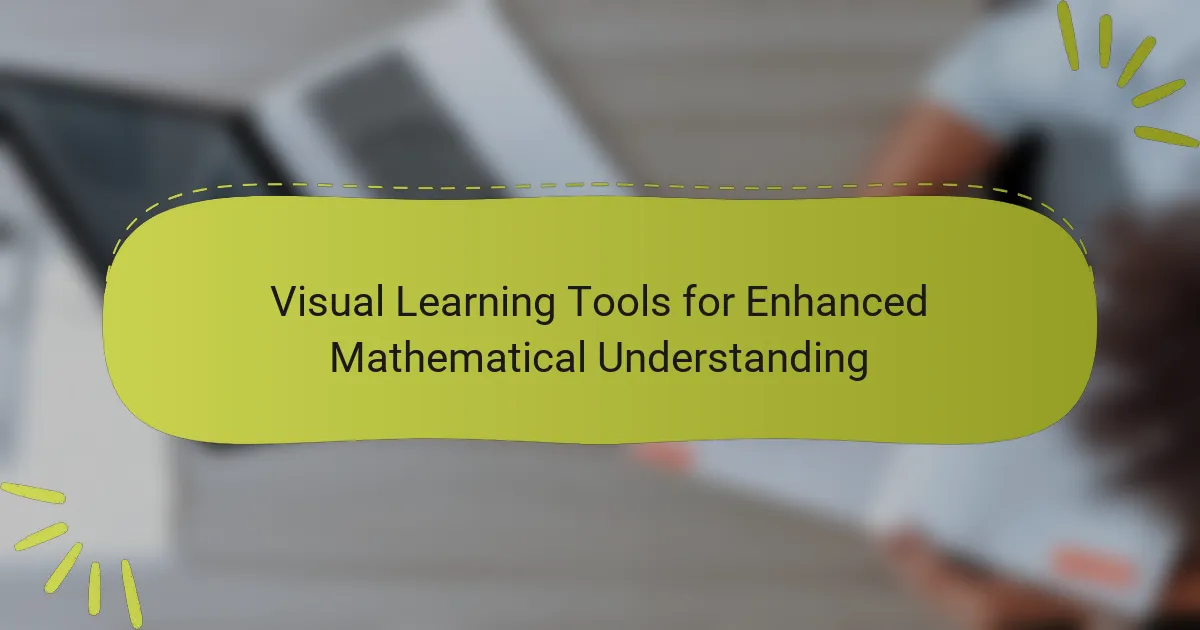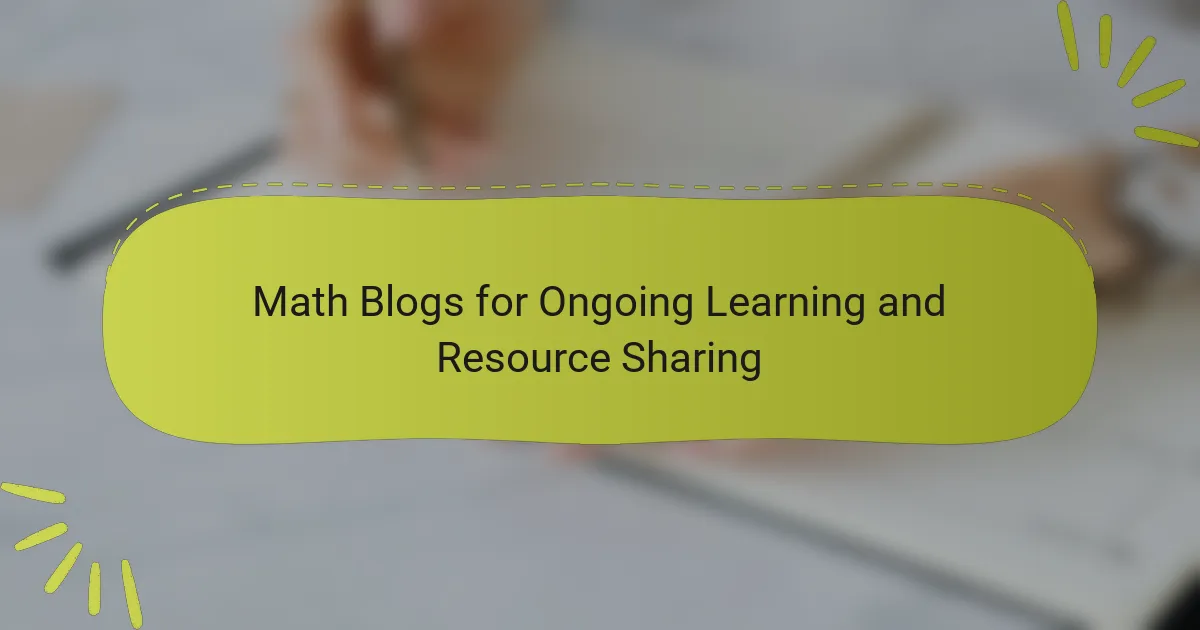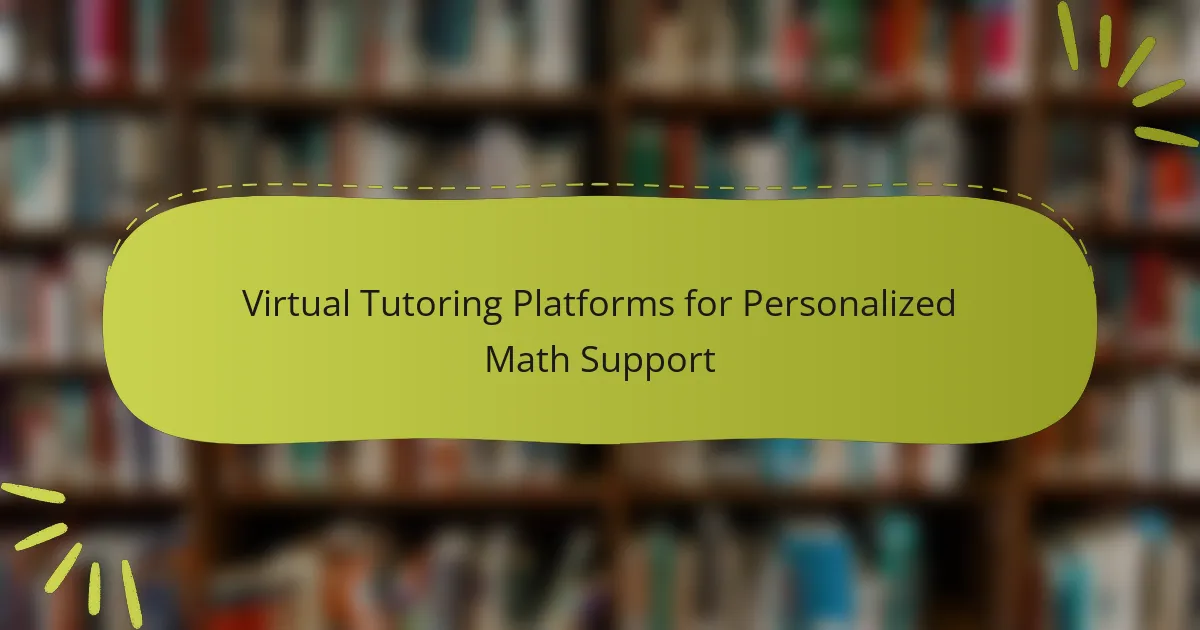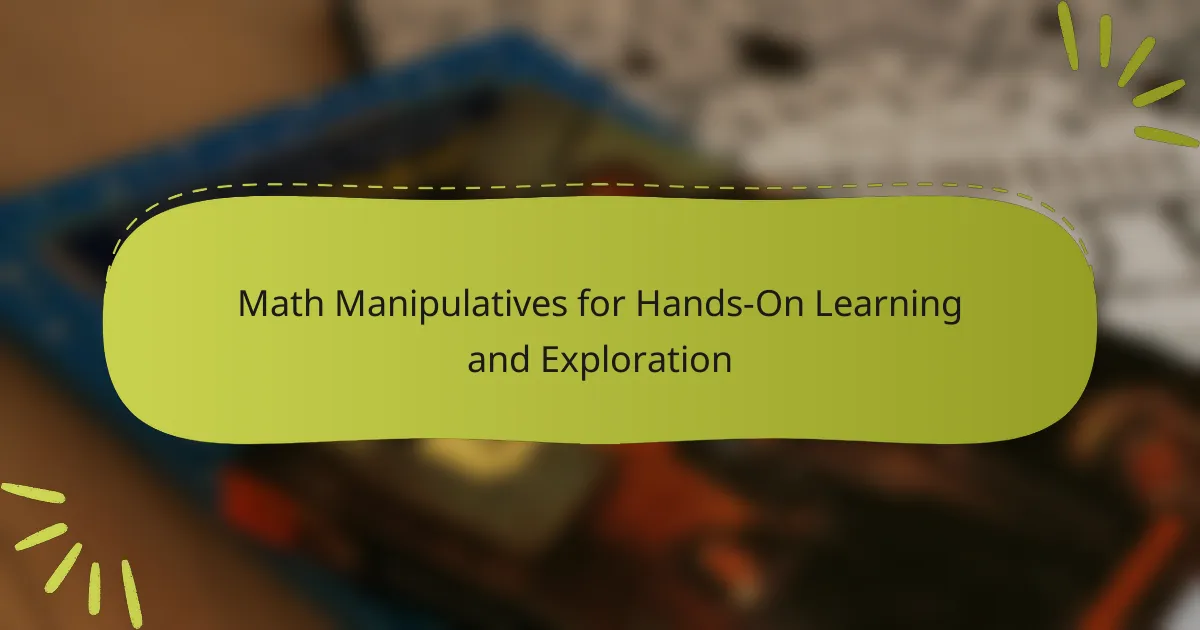Teacher guides for implementing innovative math strategies are essential resources for educators aiming to enhance their mathematics instruction. These guides encompass structured approaches, including problem-based learning, collaborative learning, and differentiated instruction, all designed to boost student engagement and understanding. They offer lesson plans, instructional strategies, and assessment tools that align with innovative teaching methods. Research indicates that these guides significantly improve teaching practices and student outcomes, highlighting the role of professional development in effective math education. Teachers can assess the effectiveness of these strategies through formative assessments, student feedback, and analysis of performance data, ensuring a comprehensive evaluation of student mastery and engagement.
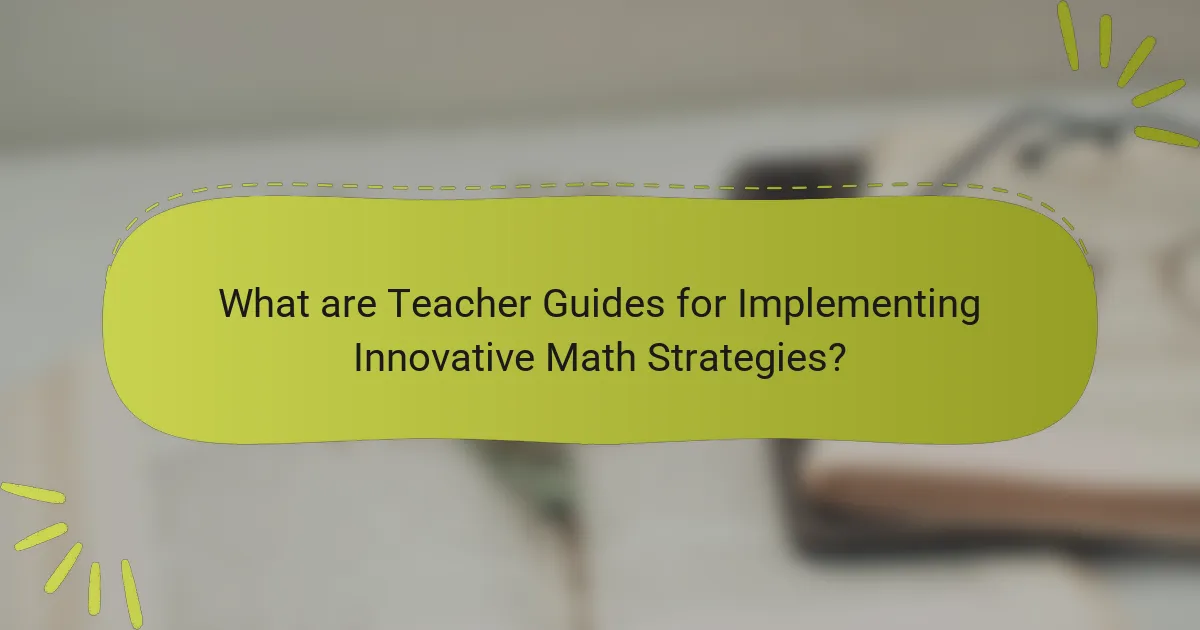
What are Teacher Guides for Implementing Innovative Math Strategies?
Teacher guides for implementing innovative math strategies are resources designed to assist educators in teaching mathematics effectively. These guides provide structured approaches and techniques to enhance student engagement and understanding. They often include lesson plans, instructional strategies, and assessment tools tailored to innovative methods. For example, they may focus on problem-based learning or the use of technology in math education. Research shows that such guides can improve teaching practices and student outcomes. A study by the National Council of Teachers of Mathematics highlights the importance of professional development resources in fostering effective math instruction.
How do Teacher Guides enhance math instruction?
Teacher Guides enhance math instruction by providing structured support for educators. They offer clear lesson plans that align with curriculum standards. This alignment helps teachers deliver consistent and effective instruction. Additionally, Teacher Guides include instructional strategies that cater to diverse learning styles. They often contain assessment tools to monitor student progress. This monitoring enables teachers to adjust their teaching methods as needed. Research shows that structured support improves teacher confidence and student outcomes. For instance, a study by the National Council of Teachers of Mathematics found that teachers using guides reported higher student engagement.
What key features should a Teacher Guide include?
A Teacher Guide should include clear objectives for the lesson. These objectives outline what students are expected to learn. It should also contain step-by-step instructions for implementing innovative math strategies. This ensures teachers can follow along easily. Additionally, the guide should provide assessment tools to measure student understanding. These tools help evaluate the effectiveness of the strategies used. Resources for further reading or activities should also be included. These resources support teachers in expanding their knowledge and approach. Lastly, a section for reflection and feedback is essential. This encourages teachers to adapt and improve their teaching methods.
How do Teacher Guides support diverse learning styles?
Teacher Guides support diverse learning styles by providing tailored strategies that cater to various educational needs. These guides include differentiated instruction techniques, which allow teachers to address the unique preferences of each student. For example, visual learners benefit from graphic organizers and diagrams included in the guides. Auditory learners can engage with suggested group discussions and verbal explanations. Kinesthetic learners are supported through hands-on activities and interactive exercises outlined in the guides. Research indicates that using varied instructional methods can enhance student engagement and retention. A study by Tomlinson (2001) emphasizes that differentiated instruction leads to better learning outcomes for diverse learners. Thus, Teacher Guides play a crucial role in accommodating different learning styles effectively.
Why are Innovative Math Strategies important in education?
Innovative math strategies are important in education because they enhance student engagement and understanding. These strategies encourage active learning through hands-on activities and real-world applications. Research shows that students who engage with innovative methods perform better in problem-solving tasks. For instance, a study by the National Council of Teachers of Mathematics highlights improved student outcomes when using inquiry-based learning. Innovative strategies also cater to diverse learning styles, helping all students grasp complex concepts. By fostering critical thinking and collaboration, these methods prepare students for future challenges in mathematics and beyond.
What are the benefits of using innovative strategies in math teaching?
Innovative strategies in math teaching enhance student engagement and understanding. These methods often incorporate technology, hands-on activities, and collaborative learning. They cater to diverse learning styles, making math more accessible. Research shows that students taught with innovative methods score higher on assessments. A study by the National Council of Teachers of Mathematics found that active learning increases retention. Innovative strategies also foster critical thinking and problem-solving skills. These skills are essential for real-world applications of math. Overall, innovative strategies create a more dynamic and effective learning environment.
How do innovative strategies improve student engagement?
Innovative strategies improve student engagement by actively involving students in the learning process. These strategies often incorporate technology, collaborative learning, and real-world applications. For example, project-based learning allows students to work on meaningful projects that relate to their interests. This approach fosters a sense of ownership and relevance in their studies. Research shows that students participating in hands-on activities are more likely to retain information. Additionally, the use of interactive tools, such as educational software, can enhance motivation and participation. A study by the National Education Association found that engaging teaching methods significantly increase student achievement and interest in subjects. Therefore, innovative strategies create dynamic learning environments that promote higher levels of engagement.
What challenges do teachers face when implementing these guides?
Teachers face several challenges when implementing innovative math strategy guides. Limited training on new methods can hinder effective application. Many educators lack confidence in using unfamiliar techniques. Time constraints often prevent thorough integration into the curriculum. Additionally, insufficient resources can impede access to necessary materials. Resistance from students accustomed to traditional methods may also arise. Moreover, varying student needs complicate uniform implementation. A study by the National Council of Teachers of Mathematics highlights these barriers, emphasizing the importance of support and professional development for successful adoption.
What common obstacles are encountered in innovative math instruction?
Common obstacles in innovative math instruction include resistance to change among educators. Many teachers prefer traditional methods and may hesitate to adopt new strategies. Another obstacle is insufficient training in innovative techniques. Educators often lack the professional development needed to implement these approaches effectively. Additionally, limited resources can hinder the adoption of innovative practices. Schools may not have access to the necessary technology or materials. Time constraints also pose a significant challenge. Teachers frequently struggle to find time within the curriculum to explore innovative methods. Finally, student readiness can be a barrier. Some students may not be prepared for non-traditional learning approaches, impacting their engagement and success.
How can teachers overcome resistance to new strategies?
Teachers can overcome resistance to new strategies by fostering open communication. Engaging in discussions about the benefits of new methods can alleviate fears. Providing professional development opportunities helps build confidence in using innovative strategies. Collaborating with peers encourages sharing of successful experiences. Demonstrating the effectiveness of new strategies through data can persuade skeptics. Offering ongoing support ensures teachers feel comfortable implementing changes. Creating a positive school culture that values innovation can reduce resistance. Recognizing and celebrating small successes can motivate teachers to embrace new approaches.
How can teachers effectively use Teacher Guides?
Teachers can effectively use Teacher Guides by following structured approaches. First, they should familiarize themselves with the contents and objectives outlined in the guide. This understanding helps in aligning lesson plans with educational goals. Next, teachers can adapt the suggested activities to fit their classroom dynamics. Customization ensures that the strategies resonate with students’ learning styles.
Additionally, teachers should utilize the assessment tools included in the guides. These tools provide valuable feedback on student progress. Collaboration with colleagues can enhance the implementation of strategies. Sharing insights and experiences fosters a supportive teaching environment.
Finally, ongoing reflection on the effectiveness of the strategies is crucial. Teachers can make adjustments based on student outcomes and engagement levels. This iterative process leads to continuous improvement in teaching practices.
What steps should teachers follow to implement strategies from the guides?
Teachers should follow a systematic approach to implement strategies from the guides. First, they should familiarize themselves with the content of the guides. Understanding the objectives and methods outlined is crucial for effective implementation. Next, teachers should select specific strategies that align with their classroom goals. This targeted selection allows for focused application.
After selecting strategies, teachers should plan lessons that incorporate these methods. This planning should include clear objectives and assessment criteria. Then, teachers should engage students with the selected strategies during lessons. Active participation enhances student understanding and retention.
Finally, teachers should evaluate the effectiveness of the implemented strategies. Gathering feedback from students and assessing their performance can provide insights into what works. Adjustments can be made based on this evaluation to improve future implementation. This structured process ensures that the strategies are effectively integrated into teaching practices.
How can collaboration among teachers enhance the use of these guides?
Collaboration among teachers can significantly enhance the use of guides for implementing innovative math strategies. When teachers work together, they can share insights and experiences related to the guides. This exchange fosters a deeper understanding of the strategies presented in the guides. Additionally, collaborative planning allows teachers to tailor the guides to meet the specific needs of their students. Research shows that collaborative teaching practices lead to improved student outcomes. For example, a study by the American Educational Research Association found that teacher collaboration positively impacts student achievement in mathematics. By collaborating, teachers can also provide mutual support and encouragement, which can lead to more effective implementation of the guides.
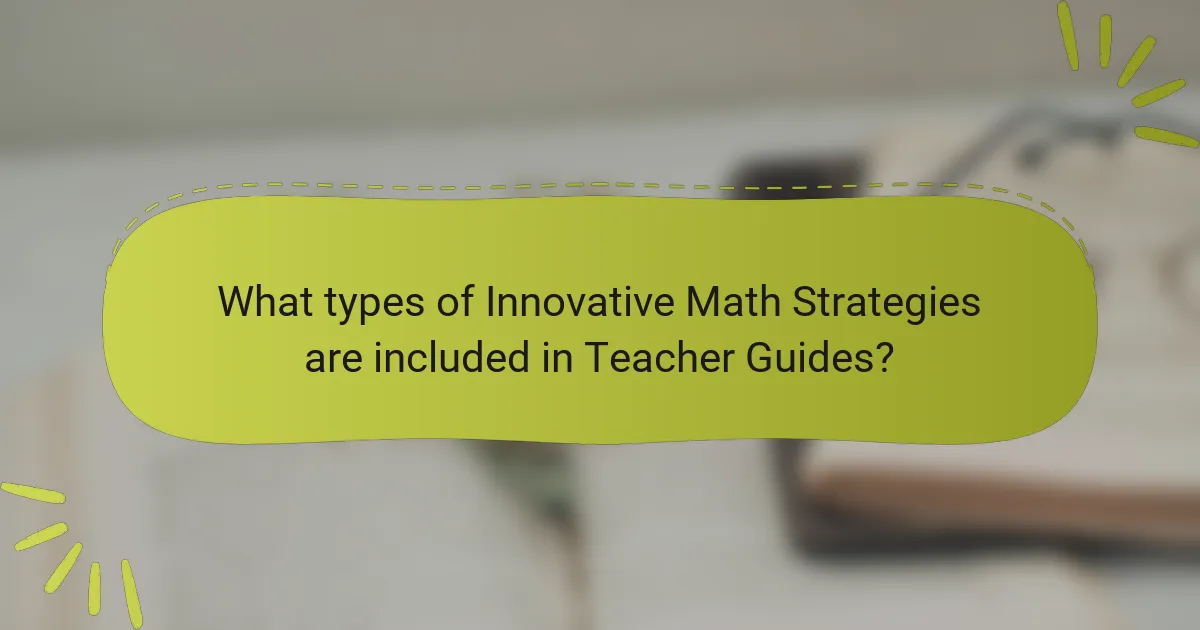
What types of Innovative Math Strategies are included in Teacher Guides?
Teacher guides include various innovative math strategies such as problem-based learning, collaborative learning, and differentiated instruction. Problem-based learning encourages students to solve real-world problems, enhancing critical thinking. Collaborative learning promotes teamwork and communication skills among students. Differentiated instruction tailors teaching methods to meet diverse student needs. These strategies aim to engage students and improve mathematical understanding. Research shows that these methods can lead to better academic performance in math.
How do these strategies vary by grade level?
Strategies for implementing innovative math vary significantly by grade level. In early grades, strategies focus on hands-on activities and visual aids. These methods help young learners grasp fundamental concepts through play and exploration. As students progress to middle grades, strategies shift to include more abstract reasoning and problem-solving tasks. This transition encourages critical thinking and application of concepts in varied contexts. In high school, strategies often emphasize real-world applications and advanced problem-solving techniques. This prepares students for college-level math and practical situations. Research shows that age-appropriate strategies enhance engagement and understanding, leading to improved math performance across grade levels.
What specific strategies are recommended for elementary students?
Specific strategies recommended for elementary students include hands-on learning activities, visual aids, and collaborative group work. Hands-on activities engage students actively in the learning process. Visual aids, such as charts and diagrams, help clarify complex concepts. Collaborative group work fosters communication and problem-solving skills. Research shows that these strategies enhance understanding and retention of mathematical concepts. According to the National Council of Teachers of Mathematics, active learning approaches improve student performance in math.
Which strategies are most effective for middle and high school students?
Effective strategies for middle and high school students include differentiated instruction, collaborative learning, and formative assessment. Differentiated instruction tailors teaching methods to meet diverse student needs. Collaborative learning encourages teamwork and peer support, enhancing engagement. Formative assessment provides ongoing feedback to improve student understanding. Research shows that these strategies lead to higher academic achievement. For example, a study by Tomlinson and Strickland (2005) highlights the positive impact of differentiated instruction on student performance.
What role does technology play in these innovative strategies?
Technology enhances innovative math strategies by providing interactive tools and resources. It allows teachers to create engaging learning environments. Digital platforms facilitate personalized learning experiences. Tools like educational software and apps help track student progress. Technology also supports collaborative learning through online forums and resources. Data analytics can inform instructional decisions based on student performance. Studies show that technology integration improves student engagement and achievement in math. For example, a report by the U.S. Department of Education indicates that technology use in classrooms can lead to higher test scores.
How can digital tools enhance math learning experiences?
Digital tools can enhance math learning experiences by providing interactive and engaging platforms for students. These tools offer visual representations of mathematical concepts. For example, software like GeoGebra allows students to manipulate geometric figures dynamically. This interactivity fosters deeper understanding and retention of concepts. Additionally, digital tools often include immediate feedback mechanisms. Programs like Khan Academy provide instant assessments that help identify areas for improvement. Furthermore, these tools can cater to diverse learning styles. They offer various formats, such as videos, games, and simulations, to accommodate different preferences. Research shows that students using digital tools demonstrate increased motivation and achievement in math. A study by the U.S. Department of Education found that technology-enhanced instruction leads to better learning outcomes. Overall, digital tools create a more personalized and effective learning environment for math education.
What are some examples of technology-integrated math strategies?
Examples of technology-integrated math strategies include the use of interactive software, online simulations, and digital tools. Interactive software like GeoGebra allows students to visualize mathematical concepts. Online simulations, such as those offered by PhET, provide hands-on experiences in exploring math and science. Digital tools like graphing calculators and math apps enhance problem-solving skills. Additionally, platforms like Khan Academy offer personalized learning experiences in mathematics. These strategies leverage technology to engage students and improve understanding. Research shows that technology integration can boost student achievement in math (Hattie, 2009).
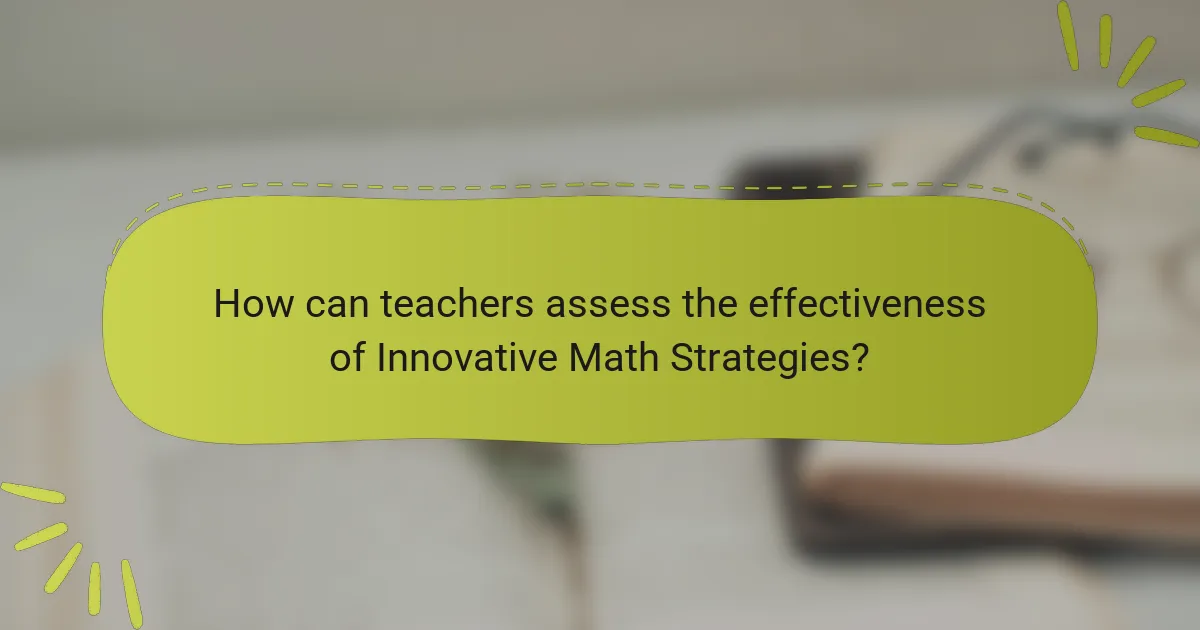
How can teachers assess the effectiveness of Innovative Math Strategies?
Teachers can assess the effectiveness of innovative math strategies through various methods. They can use formative assessments to gauge student understanding during lessons. Observations of student engagement and participation provide immediate feedback on strategy effectiveness. Standardized test scores can show long-term impacts of these strategies on student performance. Additionally, collecting student feedback through surveys can highlight areas of improvement. Analyzing student work samples allows teachers to evaluate mastery of concepts. Comparing pre- and post-implementation data can demonstrate progress. Utilizing peer reviews among teachers can provide insights into strategy effectiveness. These methods collectively offer a comprehensive assessment framework.
What assessment methods can be used to evaluate student understanding?
Assessment methods to evaluate student understanding include formative assessments, summative assessments, and performance-based assessments. Formative assessments occur during the learning process. They provide ongoing feedback to both teachers and students. Examples include quizzes, discussions, and observational assessments. Summative assessments evaluate student learning at the end of an instructional unit. They typically include final exams or standardized tests. Performance-based assessments require students to demonstrate knowledge through real-world tasks. These might involve projects, presentations, or practical applications of skills. Each method serves to gauge student comprehension and inform instructional decisions.
How can formative assessments guide instruction adjustments?
Formative assessments can guide instruction adjustments by providing real-time feedback on student understanding. Teachers can use this feedback to identify areas where students struggle. For instance, if many students perform poorly on a specific concept, the teacher can revisit that topic. This approach allows for targeted interventions tailored to student needs. Research shows that formative assessments can improve student performance by 30% when used effectively. By analyzing assessment data, educators can modify their teaching strategies to enhance learning outcomes.
What role do summative assessments play in evaluating strategy effectiveness?
Summative assessments play a crucial role in evaluating strategy effectiveness. They measure the outcomes of educational strategies after implementation. These assessments provide data on student learning and understanding. They help educators determine whether the strategies meet educational goals. Summative assessments can include tests, projects, or standardized exams. The results inform decisions about future instructional strategies. Research shows that effective summative assessments align with learning objectives. They also provide insights into areas needing improvement.
What best practices should teachers follow when using Teacher Guides?
Teachers should follow several best practices when using Teacher Guides. First, they should thoroughly review the guide before implementation. This ensures familiarity with the content and strategies. Next, teachers should adapt the guide to meet their specific classroom needs. Customization enhances relevance and effectiveness. Additionally, teachers should engage in collaborative discussions with colleagues about the guide. This fosters shared insights and diverse perspectives. Teachers should also incorporate student feedback when using the guide. Student input can highlight areas for improvement. Furthermore, regular reflection on the guide’s effectiveness is essential. This practice allows for ongoing adjustments and enhancements. Lastly, teachers should stay updated with any revisions to the guide. Updated materials may include new strategies or research findings.
How can teachers ensure continuous improvement in their teaching methods?
Teachers can ensure continuous improvement in their teaching methods by regularly assessing their instructional practices. They should gather feedback from students to understand their learning experiences. Utilizing peer observations can provide valuable insights into effective strategies. Engaging in professional development opportunities enhances teaching skills and knowledge. Incorporating data-driven decision-making helps identify areas for improvement. Setting specific, measurable goals for teaching can guide progress. Reflecting on lessons after implementation allows for adjustments and refinements. Research indicates that teachers who engage in these practices see marked improvements in student outcomes.
What resources are available for ongoing professional development in math instruction?
Resources for ongoing professional development in math instruction include online courses, workshops, and professional learning communities. Organizations such as the National Council of Teachers of Mathematics (NCTM) provide various resources. Online platforms like Coursera and EdX offer courses focused on innovative math teaching strategies. Local school districts often host workshops to enhance instructional practices. Additionally, educational conferences feature sessions dedicated to math instruction improvement. Professional learning communities allow educators to collaborate and share best practices. Research indicates that ongoing professional development positively impacts teaching effectiveness and student learning outcomes.
Teacher guides for implementing innovative math strategies are essential resources that assist educators in enhancing mathematics instruction. These guides provide structured lesson plans, instructional strategies, and assessment tools tailored to innovative teaching methods, such as problem-based learning and technology integration. Key features include clear objectives, differentiated instruction techniques to support diverse learning styles, and resources for further reading. The article also addresses the benefits of innovative strategies in improving student engagement and understanding, as well as the challenges teachers may face during implementation. Additionally, it explores assessment methods and best practices for effective use of teacher guides in the classroom.
